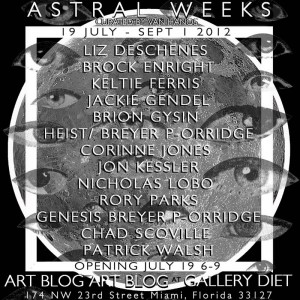Art Blog Art Blog presents Astral Weeks curated by Van Hanos Opening
 Thursday, July 19, 6-9 pm
Thursday, July 19, 6-9 pm
Gallery Diet
174 Nw 23 Street
Miami Fl 33127
www.gallerydiet.com
Liz Deschenes, Brock Enright, Keltie Ferris, Jackie Gendel, Brion Gysin, Heist/Breyer P-Orridge, Corinne Jones, Jon Kessler, Nicholas Lobo, Rory Parks, Genesis Breyer P-Orridge, Chad Scoville, Patrick Walsh
July 19 – September 1, 2012
Gallery Diet is pleased to present a group show curated by artist Van Hanos. This show is the second in a two-part series of exhibitions presented by ART BLOG ART BLOG at Gallery Diet in summer 2012.
This exhibition stems from the ideas and questions motivated by a single artwork by Brion Gysin. The Dream Machine is an anomaly within the history of art, the only known artwork that is fully activated as the viewer closes their eyes. Taken as such, it suggests an evaluation of how artwork is viewed; its function, its value, and the language we use to engage with it.
Bringing together a wide range of practices, each artist investigates both the limits of set material conditions and ways of seeing by exploring physical mechanics, preconceptions of form and abstraction, and the relationship between the object and how it is perceived.
To view the Dream Machine:
With eyes closed
Unique to each viewer, the experience cannot be visually documented or reproduced. It expands the gap between seeing and deciphering what is seen. The Machine produces a flickering light frequency akin to alpha waves stimulating the brain’s occipital lobe, causing a waking dream, psychedelic experience with the mind’s eye view. The participant is called to a reinvigorated conversation of what, and how, one sees.
With eyes open
The viewer is not engaged in the occipital lobe state which allows for a shared experience and for critical observation of the work. Here, the flicker effect producing the mind’s eye view no longer holds sway. At distance, the sculpture becomes a rotating projector transforming the room with perpetual movement of shapes of light; the object itself is a center-piece, evocative of a silent bonfire. Like witnessing a performance, silent film, or sculpture, a familiarity is maintained between the viewer and work.
This introduction of a new way of viewing, as simple as it may be, presents a dramatic shift in what may be the task set ahead of the artist. This is not to proclaim that new ways of viewing are now criteria for successful work but rather Gysin’s exemplar reminds us, thankfully, that no part of the art making process is fixed—calling to question the status quo of function, inspiration, and execution—and creating a productive artistic dilemma inviting a more engagedand rigorous exploration of ideas.

